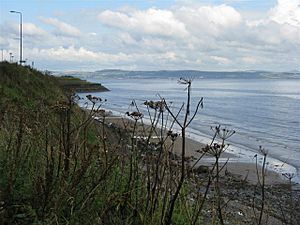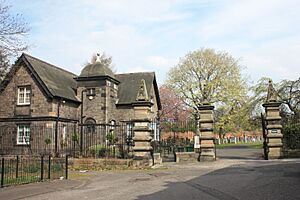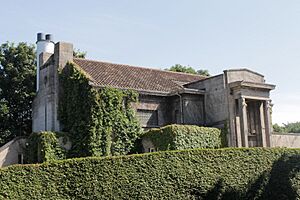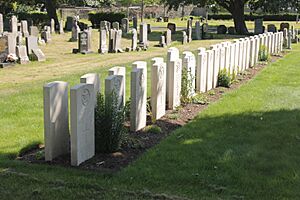Seafield, Edinburgh facts for kids
Seafield is a coastal area in north-east Edinburgh, Scotland. It sits right by the Firth of Forth, which is a large bay. Seafield is mostly a business area, so there aren't many homes there.
This area is also home to the Edinburgh Dog and Cat Home. This special place looks after about 150 lost and abandoned cats and dogs from Edinburgh and the surrounding areas.
An important hospital called the Eastern General Hospital used to be here. It was taken down in 2008. Its maternity unit, where babies were born, served this part of Edinburgh until 1997.
Contents
Seafield Cemetery and Crematorium
Seafield Cemetery opened in 1889. It has a grand entrance with gates and a lodge building. The crematorium, where bodies are cremated, was built later in 1938. It was designed by an architect named W. N. Thomson.
The cemetery has special areas, including a columbarium for ashes and an Italian-style section. Some interesting people are buried here:
- Bernard Hunter, a well-known businessman.
- Alex Young, a famous footballer who played from 1880 to 1959. His grave got a new stone in 2017.
War Graves at Seafield
There are many war graves in Seafield Cemetery. This is partly because the Eastern General Hospital nearby was used as a military hospital during the Second World War. Many soldiers who died from injuries or illness were buried here.
You can also find graves of trawlermen, who were fishermen. During the First World War, the government used their boats and skills to clear dangerous mines from the sea. These brave crews were part of the Royal Navy Reserve.
The cemetery holds the graves of 185 Commonwealth service members from the First World War. Some are in special military plots, while others are spread out. There are also 104 service members from the Second World War buried here, including five sailors who could not be identified. A memorial stands for 22 service members from the Second World War who were cremated at the crematorium.
Some Canadian war graves are near the main entrance. This includes two members of the Canadian Forestry Corps.
Many naval graves in the cemetery tell sad stories. They belong to people who died from wounds or illness far from home. Some are also for bodies that washed ashore in the Firth of Forth.
- Radio Operator Glyndwr B Brown died in 1941 from injuries after his ship, SS Dalemoor, was captured by German forces.
- O/s W. H. Clarke was only 18 when he died in 1939 from injuries received on HMS Cossack.
- Three officers from HMT Firefly, a fishing boat turned into a minesweeper, died in 1940. Their ship was destroyed by a loose British mine in the Firth of Forth.
- A/s G. Gray was killed in 1918 when a U-boat torpedoed his ship, SS Malvina.
- Fireman J. Henderson died in 1919 after an attack on his ship, SS Northumbria.
- Hendrik V D Hoogh and Willem Adriaan Staalenburg were Dutch seamen. Willem was only 16 when he died in 1940 from North Sea injuries.
- Seven crew members from HMS Saucy, a rescue tug and minesweeper, died in 1940. Their ship was blown up by a mine in the Firth of Forth.
- Two sailors were killed in 1943 by an accidental explosion in Leith Docks.
- Five men died in 1939 when HMS Cossack crashed into another ship, SS Borthwick, in the Firth of Forth.
Seafield Waste Water Treatment Works
On the north side of the A199 road, you'll find the Seafield Waste Water Treatment Works (WWTW). This is the biggest facility in Scotland that cleans waste water.
This plant, run by Scottish Water, cleans 300 million litres of waste water every single day. That's enough to fill 121 Olympic-sized swimming pools! It's also big enough to handle the waste water for 850,000 people in the future.
The site also has a special plant that uses waste gases to create electricity. This Combined Heat and Power plant can make up to 2300 kilowatts of clean electricity. That's enough to power about 600 homes! It also treats the leftover waste so it can be used for farming.
In 2012, a plan was started to improve the smell from the plant. However, people living nearby still complained about strong odours. So, in 2021, another £10 million was invested to improve how sludge is stored there.





